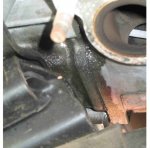Gidday Dave
Is your car using any oil? If so, how much?
Our Camry was leaking oil (dripping on the driveway), but the amount was so little as to be insignificant between oil changes (at 10,000 Km or 12 month intervals).
Basic rule with alloy heads and blocks is to check that they are flat using a workshop straight edge across in all directions. It is far easier to machine either or both surfaces while the engine is stripped down than it is to do it after re-assembly ... :iconwink:

:lol:.
Also follow the OEM tightening torque, sequence and procedure for all components to the letter, including cam carriers and the like. It is usual to tighten all head nuts/bolts to finger tight in sequence before commencing using a torque wrench on them. This settles the head/gasket/block alignment and mating before applying any real force to the hold-down bolts/nuts. Finger tight is about 1 to 2 ft. lbs. torque. Same goes for the cam carrier nuts/bolts.
I have always tensioned heads in steps, following the sequence for each step.
Say the recommended torque is 60 ft. lbs., I would start with finger tight, then set the torque wrench to 5 ft. lbs.; then 15; then 30; then 45; then 60 ft.lbs.
This takes a bit longer, but after having an engine that would leak at the head gasket at the drop of a feather, one realises that the forces being applied need to be applied gradually and very evenly. BTW, that particular engine had a cast iron head and block (it was a straight six). Alloy heads and blocks are even more 'flexible'. After working this procedure out, none of the head gaskets I worked on ever leaked again ... :ebiggrin: :biggrin:.
Remember to re-set the tappet clearances afterwards ... :iconwink:.



 :lol:.
:lol:.